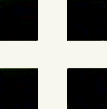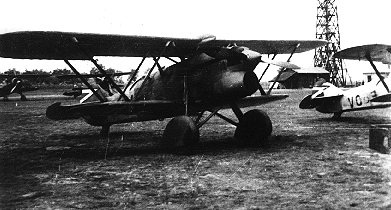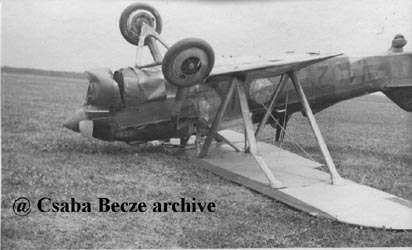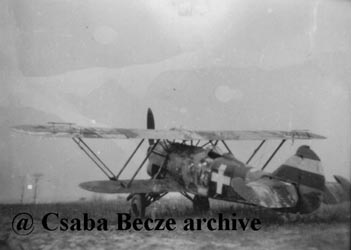


Following the signing of the Rome Protocol with Italy in 1935, the Magyar Légügyi Hivatal (Hungarian Aviation Department) ordered 26 Fiat CR.32s and 26 more the following year. The 52 aircraft arrived in Hungary between 23 April and 2 December 1936. The CR.32s were armed with two Hungarian made 7.92mm M. GKH type Gebauer machine guns. The fighters were assigned to I. Metrological Group, which was moved from Szombathely to Székesfehervar during 1936. The group was composed by three sub-groups: 1/1. ‘Ilász’ (Archer) vadászszázad (fighter squadron), 1/2. ‘Ludas Matyi’ (Matti the Goose Boy - a Hungarian folklore character) vadászszázad and 1/3. ‘Puma’ (Mountain Lion) vadászszázad.
In 1938 the Hungarians received 36 ex-Austrian CR.32s from Germany.
On 22 August 1938 an agreement was signed in Bled, Yugoslavia by Hungary and the ‘Little Entente’ states – Czechoslovakia, Rumania and Yugoslavia. This agreement recognized Hungary’s right to rearm itself in exchange for Hungary’s promise not to forcibly reclaim territory lost under the 1920 Peace Treaty of Trianon. The now legal Magyar Királyi Honvéd Légierö (Royal Hungarian Air Force) first went on alert during the Munich Crisis in October 1938.
On 25 October 1938 Föhadnagy László Pongrácz downed a Czech S-328 from 10 Squadron over Hodzovo.
The Letov's pilot, Corporal Ján Kello was wounded and the observer, aspirant Jaromir Sotola was killed.
This claim isn't a confirmed victory and his commanders punished him since it took place during a very sensitive period. This incident was direct before the first Wiener judgment when Hungary got back former territories where the ethnic majority was Hungarian (2 November 1938).

On 23 March 1939 – following Germany’s seizure of Bohemia and Moravia – Hungary reoccupied the easternmost Slovak province of Upper Hungary (Ruthenia). Slovak aircraft attacked the advancing Hungarian troops that day, prompting the Hungarian Air Force into action the next day.
During 24 March CR.32s of 1/1. and 1/2. vadászszázad engaged Slovak Avia B-534s twice over Ruthenia and Hungary.
Hungarian Ju86K-2 bombers attacked Spisska Nova Ves’ airport. The bombers were escorted by CR.32s from the 1/2. vadászszázad.
On the morning of 24 March 1939 föhadnagy (Lieutenant) Aladár Negró’s 2. Section of the 1/1. vadászszázad was patrolling the area over Szobránc. The section consisted of him, örmester (Sergeant) Sandor Szojak and örmester Árpád Kertész. At 07:40 three Slovakian Avia B-534s from 49th letka suddenly appeared. In the ensuing brief aerial combat Negró shot down porucík (Lieutenant) Ján Prhácek (commanding officer of the 49th letka) west of Sobrance. Prhácek was killed when his fighter crashed. Szojak shot down desiatnik (Corporal) C. Martis, who survived, near Lúcky. Kertész claimed a third fighter, flown by LAC Michal Karas, damaged in the area of Vysne Remety in East Slovakia. In fact Karas landed at his base without any damage to his Avia.
At 15:00 the 1/1. vadászszázad scrambled. They formed in three Vs in the air; föhadnagy Béla Csekme leading with hadnagy (2nd Lieutenant) V. Gemeinhardt and örmester M. Tarr as wingmen. Negró’s trio flew on the starboard side and on the port side flew föhadnagy László Palkó’s 3. Section, with wingmen Antal Békássy and hadnagy Mátyás Pirity. The CR.32s reached the cloud-base at about 6200 feet and then flew into fog. Soon there was a hole in the clouds and at the same moment Palkó and Pirity noticed three Avia B-534s and three Letov Š.328s on the port side. The 1. Section did not appear to notice the enemy and they flew on and were soon swallowed by the fog. The Avias, which were from 45th letka, jumped Negró’s 2. Section but opened fire too soon, outside the range of their machine-guns. Negró, turned the table and shot down one Avia flown by rotmajster Ján Hergott southeast of Bánovce nad Ondavou. A second Avia, flown by František Hanovec, was shot down by Szojak near Senné.
The Letovs, which were from 12th letka on their way to bomb Hungarian troops at Sobrance, were deserted by their escort and offered a tempting target. They were 300 feet higher thus, in order to gain speed and altitude, Palkó threw his machine into a short dive and then climbed behind the Letovs. He dipped the nose of his CR.32 and sent a burst into the belly of the nearest one. The aircraft caught fire and crashed north of Pavlovce nad Uhom. The pilot slobodník Gustáv Pažický and the observer porucík Ferdinand Švento were both killed. A second Letov was claimed shot down by Pirity. This was a Letov flown by slobodník Jozef Drlicka and his observer podporucík L. Šronk and they made an emergency landing near Strazske.
Three more Avias were discovered and Palkó’s wingmen were now locked in combat with the enemy fighter. Békássy pursued one over the border and emptied a total of a thousand rounds from both machine guns into it before shooting it down. This aircraft was flown by desiatnik Martin Danihel from 45th letka and he made an emergency landing near Brezovice nad Torysa. After having expending all his ammunition Békássy returned to Hungary.
Looking around Pirity saw streams of tracers scorching the sky then noticed an Avia some 1500 feet below. Pirity dived on it but he had to pull out because another CR.32 crossed his path with guns blazing. The sky was now empty, Palkó, staying in the area for a minute or two, sighted Negró’s machine. One by one the other Fiats joined them. Békássy and Szojak had already landed at Ungvar.
The Hungarian pilots totally claimed five Avias and two Letovs in the air combat over Paloc. Negró, Békássy, Szojak, Béla Csekme (not confirmed) and Kertész (one not confirmed over Michalovce) reported the destruction of the Avias, while Palkó and Pirity claimed the Letovs. Gemeinhardt and Tarr had no chance to fire their guns in anger. The Slovakian forces lost three Avia B-534s and two Letovs. Slovakian pilots Hanovec and Danihel both claimed one Fiat but this was not confirmed with the Hungarians.
Porucík Ferdinand Švento, the observer of one of the Letovs, baled out and was wounded in the stomach while descending in his parachute. He fell near a group of Hungarian hussars. Upon impact he forced himself to sit up and reached inside his flying gear. The move was misunderstood and Švento was mortally shot. The hussars found his identification papers in his hand instead of a pistol. Švento was buried with full military honours.
The conflict ended with the signing of a ‘Border Treaty’ by Hungary and Slovakia on 28 March 1939.

By the end of 1939, 1/3. vadászszázad relinquished its CR.32s and was redesigned 2/2. vadászszázad, while 1/1. vadászszázad was renamed ‘Dongó’ (Bumble Bee).
Hungary allowed German forces to attack Yugoslavia from Hungarian territory on 6 April 1941. One week later, Hungarian troops advanced into northern Yugoslavia. CR.32s from 1/1. vadászszázad and 1/2. vadászszázad assisted other Air Force units in supporting friendly forces during this brief campaign. Two CR.32s were lost and another aircraft was damaged in the fighting before Yugoslavia forces facing Hungary surrendered on 13 April.
On 22 June 1941 – the day Germany invaded the Soviet Union – 1/1. vadászszázad was based at Ungvár (now Ushgorod , Ukraine) and 1/2. vadászszázad was located at Felsöábrány. These units were responsible for defending the industrial cities of Miskolc and Diósgyör.
At 12:58 on 26 June, three unknown twin-engine aircraft bombed the northern Hungarian city of Kassa (now Kosice, Slovakia). All available CR.32s were scrambled to intercept, however, the bombers escaped without loss.
Hungary’s War Cabinet identified the attacking aircraft as Soviet, and declared war on the Soviet Union that day.
On 4 July, 23 Fiat CR.32s of the 1/1. vadászosztály moved to Miskolc.
Soon after this the obsolete Fiat CR.32s were relegated to fighter training duties.
Known Hungarian claims with the Fiat CR.32:
| Kill no. | Date | Number | Type | Result | Pilot | Plane type | Serial no. | Locality | Unit |
| 1938 | |||||||||
| 1 | 25/10/38 | 1 | Letov S-328 (a) | Destroyed | László Pongrácz | Fiat CR.32 | Hodzovo | 1/2. vadászszázad | |
| 1939 | |||||||||
| 2 | 24/03/39 | 1 | Avia B-534 (b) | Destroyed | Aladár Szobránczy | Fiat CR.32 | W Sobrance | 1/1. vadászszázad | |
| 3 | 24/03/39 | 1 | Avia B-534 (c) | Destroyed | Sándor Szobránci | Fiat CR.32 | near Lúcky | 1/1. vadászszázad | |
| 24/03/39 | 1 | Avia B-534 (d) | Damaged | Árpád Kertész | Fiat CR.32 | Vysne Remety area | 1/1. vadászszázad | ||
| 4 | 24/03/39 | 1 | Avia B-534 (e) | Destroyed | Aladár Szobránczy | Fiat CR.32 | SE Bánovce nad Ondavou | 1/1. vadászszázad | |
| 5 | 24/03/39 | 1 | Avia B-534 (f) | Destroyed | Sándor Szobránci | Fiat CR.32 | near Senné | 1/1. vadászszázad | |
| 6 | 24/03/39 | 1 | Avia B-534 (g) | Destroyed | Antal Békássy | Fiat CR.32 | near Brezovice nad Torysa | 1/1. vadászszázad | |
| 7 | 24/03/39 | 1 | Avia B-534 (h) | Destroyed | Béla Csekme | Fiat CR.32 | 1/1. vadászszázad | ||
| 8 | 24/03/39 | 1 | Avia B-534 (i) | Destroyed | Árpád Kertész | Fiat CR.32 | Michalovce | 1/1. vadászszázad | |
| 9 | 24/03/39 | 1 | Letov Š.328 (j) | Destroyed | László Palkó | Fiat CR.32 | N Pavlovce nad Uhom | 1/1. vadászszázad | |
| 10 | 24/03/39 | 1 | Letov Š.328 (k) | Destroyed | Mátyás Pirity | Fiat CR.32 | near Strazske | 1/1. vadászszázad |
TOTAL: 10 destroyed, 1 damaged.
(a) Czech S-328 from 10 Squadron shot down. The pilot, Corporal Ján Kello was wounded and the observer, aspirant Jaromir Sotola was killed.
(b) Claimed in combat with 49th letka. Commanding officer porucík (Lieutenant) Ján Prhácek killed.
(c) Claimed in combat with 49th letka. Desiatnik (Corporal) C. Martis survived.
(d) Claimed in combat with 49th letka. Michal Karas’ Avia was undamaged.
(e) Claimed in combat with 45th letka. Rotmajster Ján Hergott shot down.
(f) Claimed in combat with 45th letka. František Hanovec shot down.
(g) Claimed in combat with 45th letka. Desiatnik Martin Danihel made an emergency landing.
(h) Claimed in combat with 45th letka.
(i) Not confirmed. Claimed in combat with 45th letka.
(j) Letov Š.328 from 12th letka shot down. The pilot slobodník Gustáv Pažický and the observer porucik Ferdinand Svento were both killed.
(k) Letov Š.328 from 12th letka flown by slobodník J. Drlicka and his observer podporucík L. Šronk, which made an emergency landing near Strazske.
Sources:
Csaba Becze: A magyar királyi 1. honvéd éjjeli vadász repülõszázad Magyar Repüléstörténeti Társaság Konferencia Közleményei 1999 kindly provided by Csaba Becze
Biplane Against The Red Bear - Julius R. Gaal, 1974 Air Combat Spring/1974 kindly provided by Santiago Flores
Fiat CR 32/CR 42 in action - George Punka, 2000 Squadron/Signal Publications, Carrollton, ISBN 0-89747-411-2
Harcok az orosz égen Budapest - Tomor László, 1942 kindly provided by Csaba Becze
Hungary in the WW2 lexicon A-Zs kindly provided by Milán Szekelyhidi
Elfelejtett Hősök - Csaba Becze, 2006 Puedlo Kiadó, ISBN 963-9673-064
“Kőr ász” Egy vadászrepülő század története 1936-1941 - Csaba Becze, 2007 Puedlo Kiadó, ISBN 978-9639673854
Slovenské Letectvo 1939-1944 - Juraj Rajninec, Bratislava, 1997
Tuzkeresztség - Csaba Becze, 2001 Aero magazin March 2001
Additional information kindly provided by Csaba Becze
